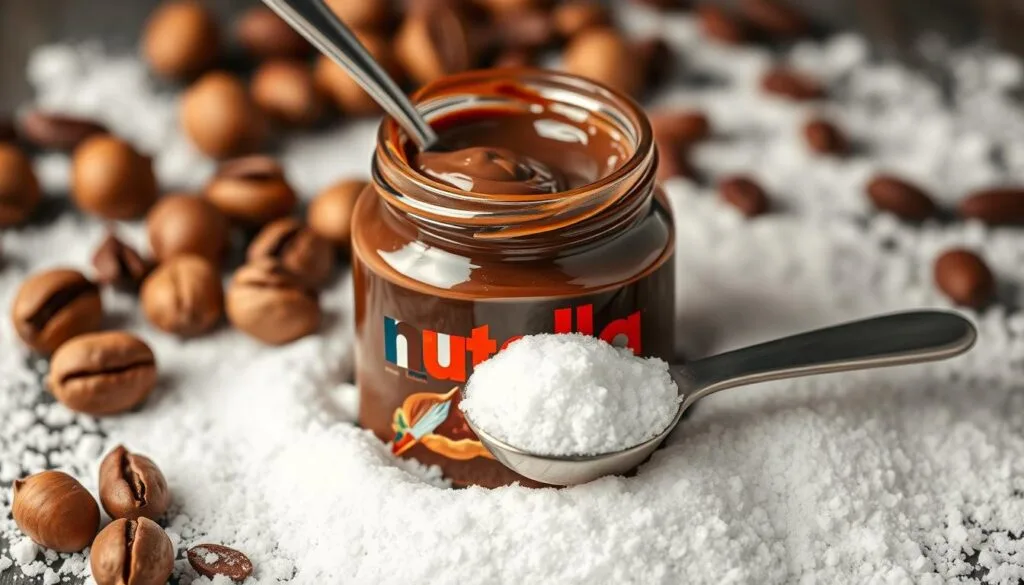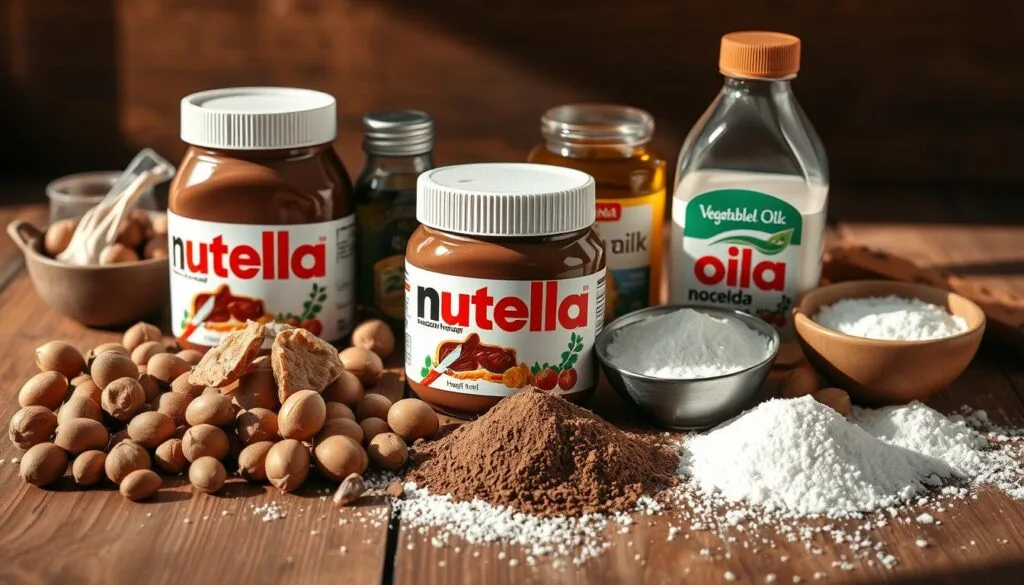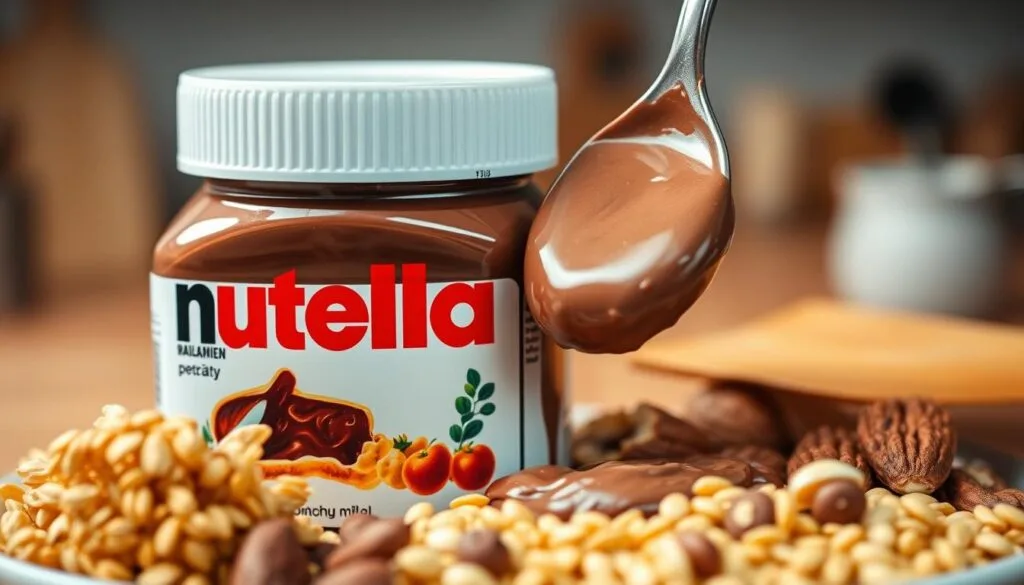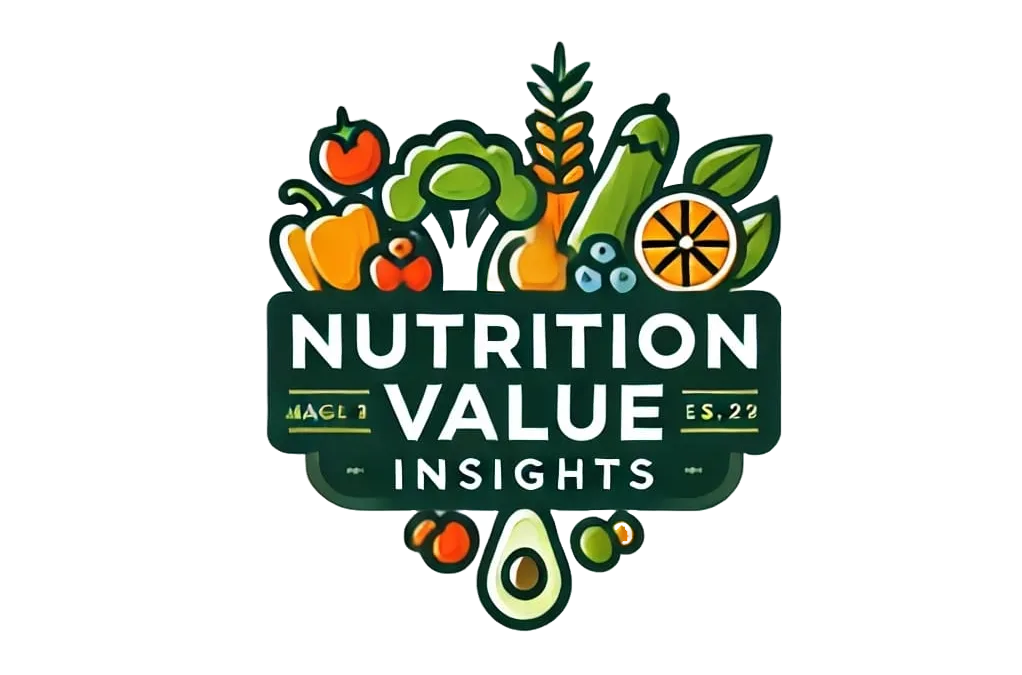Nutella Nutrition Facts : Calories, Sugar Content, and Health Insights
Nutella, the beloved hazelnut spread, is a favorite in homes around the world. But, its nutritional facts have raised many questions. We’ll explore the calories, sugar, and health effects of this tasty treat.

A 2-tablespoon serving of Nutella has about 200 calories. It has 11 grams of fat, with half being saturated. It also has 21 grams of added sugar and only 3 grams of protein. These numbers show Nutella is high in calories and sugar, making it a concern for a healthy diet.
Table of Contents
Understanding Nutella Nutrition Facts
Nutella is a mix of ingredients that make it special. It has a unique flavor and texture. Let’s look at the main parts that make Nutella what it is.
Key Components and Their Sources
The main parts of Nutella are sugar, palm oil, hazelnuts, cocoa powder, and milk powder. Together, they make Nutella creamy and indulgent.
The Role of Palm Oil in Nutella
Palm oil is a topic of debate. Some worry about its health and environmental effects. But Ferrero, Nutella’s maker, says their palm oil is safe.
Hazelnut Content and Quality
Hazelnuts are key in Nutella. They give it a unique taste and some good nutrients like vitamin E. The quality and where these hazelnuts come from affect Nutella’s taste and health.
| Ingredient | Nutritional Benefits | Environmental Impact |
|---|---|---|
| Sugar | Provides energy, but high in calories and lacks essential nutrients. | Cultivation and processing of sugar can have a significant environmental footprint. |
| Palm Oil | Rich in saturated fats, with potential health concerns when consumed in excess. | Palm oil production has been linked to deforestation and habitat loss in some regions. |
| Hazelnuts | Provide healthy fats, fiber, vitamins, and minerals, contributing to the nutritional value of Nutella. | Hazelnut cultivation generally has a lower environmental impact compared to palm oil. |
| Cocoa Powder | Cocoa contains antioxidants and can offer some health benefits in moderation. | Cocoa production can have social and environmental challenges, such as child labor and deforestation, that require attention. |
| Milk Powder | Provides protein and calcium, but also adds to the calorie and fat content of Nutella. | Dairy production has a significant environmental footprint, particularly in terms of greenhouse gas emissions. |
Knowing what’s in Nutella helps us understand its nutritional and environmental effects. It’s important to know this when enjoying Nutella.
Nutella Nutrition Facts : Essential Values Per Serving
Nutella, the chocolate-hazelnut spread, is loved worldwide. People eat 250,000 tons of it every year. Let’s look at what’s in a serving of Nutella.
A 2-tablespoon (37-gram) serving of Nutella has 200 calories. It has 22 grams of carbs, 11 grams of fat, and 2 grams of protein. This serving also has 21 grams of sugar, about 5 teaspoons.
Nutella also has vitamins and minerals. It has 4% of the daily calcium and 160 milligrams of potassium. But, it has only 1 gram of fiber and 15 milligrams of sodium.
These facts show Nutella is high in calories and sugar. It’s good to enjoy Nutella in small amounts for a balanced diet.
| Nutrient | Amount per Serving (2 tbsp, 37g) |
|---|---|
| Calories | 200 |
| Total Carbohydrates | 22g |
| Total Sugars | 21g |
| Total Fat | 11g |
| Saturated Fat | 4g |
| Protein | 2g |
| Fiber | 1g |
| Sodium | 15mg |
| Calcium | 4% of Daily Value |
| Potassium | 160mg |
Nutella’s nutella nutrition per serving and nutella calories are high. It’s mostly sugar and fat. Enjoy it in small amounts for a healthy diet.
Caloric Content and Daily Value Analysis
Nutella is a favorite chocolate-hazelnut spread known for its rich taste. But, it’s crucial to know its calorie content and how it fits into your diet. With 200 calories per 2-tablespoon serving, it can add a lot to your daily calorie count.
Serving Size Guidelines
The suggested serving size for Nutella is 2 tablespoons. But, it’s easy to eat more than that. Eating too much can lead to too many calories, which might affect your weight. It’s important to control how much you eat.
Calorie Distribution Breakdown
Nutella gets most of its calories from sugar and fat. A single serving has 21 grams of sugar and 11 grams of fat, with only 2 grams of protein. This means you should eat Nutella in small amounts as part of a balanced diet.
Impact on Daily Caloric Intake
For someone on a 2,000-calorie diet, a 2-tablespoon serving of Nutella is 10% of your daily calories. Eating Nutella often without watching your calorie intake can cause weight gain and health issues. It’s key to be careful with how much Nutella you eat and fit it into your daily calorie plan.
“Moderation is key when it comes to enjoying Nutella. While it’s a delicious treat, its high sugar and caloric content mean it should be consumed in small portions as part of an overall healthy diet.”
Sugar Content and Health Implications
Nutella, the beloved hazelnut spread, has a lot of sugar – 21 grams per 2-tablespoon serving. This high sugar is a big worry for health, especially for kids. The American Heart Association says kids should not have too much added sugar to stay healthy.
The sugar in Nutella can lead to tooth decay, obesity, and diabetes risk. While it’s okay to have Nutella sometimes, it’s not good for a regular diet, especially for kids’ growing bodies.
| Nutrient | Nutella (2 tbsp) | Recommended Daily Limit |
|---|---|---|
| Sugar | 21 g | 25 g (children) |
| Calories | 200 cal | – |
| Saturated Fat | 6 g | 16 g (children) |
Parents and caregivers should watch Nutella’s sugar and its health effects. It’s important to control how much Nutella kids eat. Look for healthier options that are lower in sugar and better for nutrition.

“While Nutella can be enjoyed in moderation, its high sugar content makes it less suitable as a regular part of a balanced diet, especially for children.”
Fat Profile and Composition
Nutella is famous for its creamy texture, thanks to its high fat content. A 2-tablespoon serving has 12 grams of fat, with 4 grams being saturated. This makes Nutella very calorie-dense, with 200 calories per serving.
Saturated vs. Unsaturated Fats
The main fat in Nutella is palm oil, which is mostly saturated. While unsaturated fats are better for your heart, Nutella’s saturated fats have raised health concerns.
Palm Oil Health Considerations
The use of palm oil in Nutella has sparked debate. Palm oil production is linked to deforestation and habitat loss. When heated high, palm oil might create harmful compounds. Ferrero says their methods avoid these issues, but the health effects of palm oil are still debated.
| Fat Type | Nutella (2 tbsp) | Peanut Butter (2 tbsp) |
|---|---|---|
| Total Fat | 12g | 16g |
| Saturated Fat | 4g | 3g |
| Unsaturated Fat | 8g | 13g |
It’s key to balance saturated and unsaturated fats for heart health. Nutella’s fat content is high, but it can be part of a balanced diet if eaten in moderation.
Protein and Carbohydrate Analysis
Nutella has a low amount of protein but lots of carbs. Each 2-tablespoon serving has 2g of protein and 22g of carbs. Most of these carbs come from added sugars, with only 1g of fiber.
It’s important to note Nutella’s low protein. If you want more protein, you might choose something else. For example, peanut butter has about 7g of protein in the same amount, making it better for protein needs.
| Nutrient | Nutella (2 tbsp) | Peanut Butter (2 tbsp) |
|---|---|---|
| Calories | 210 | 180-210 |
| Total Fat | 3.5g (4% DV) | 17g |
| Saturated Fat | 1.8g (9% DV) | 3.5g |
| Carbohydrates | 19g (7% DV) | 7g |
| Dietary Fiber | 1.4g (5% DV) | 2g |
| Protein | 6.3g (13% DV) | 7g |
Nutella isn’t the best for high protein or fiber. But, it can be part of a balanced diet if eaten in small amounts. Remember to pair it with foods that are good for you to make a better snack or meal.

Glycemic Index and Blood Sugar Impact
Nutella, the beloved hazelnut-chocolate spread, has a glycemic index (GI) of 33. This means it can cause a slow and moderate rise in blood sugar. It’s good for people managing their blood sugar, like those with diabetes, when eaten in small amounts.
Understanding GI Ratings
The glycemic index shows how fast a food raises blood sugar. Foods with a low GI (55 or below) are digested slowly, leading to a gradual blood sugar increase. High GI foods (70 or above) cause a quick spike in blood sugar. Nutella’s GI of 33 shows it has a small effect on blood sugar compared to high-GI foods.
Blood Sugar Response Studies
Many studies have looked at Nutella’s effect on blood sugar. A 2020 study found that Nutella with a meal didn’t raise blood sugar much in people with type 2 diabetes. A 2018 study also showed Nutella might have a lower glycemic response than other breakfast spreads like jam or honey.
Even though Nutella’s GI is low, its high sugar content is still important. It’s key to control portions and eat it mindfully. This is especially true for those managing diabetes or following a healthy diet.
In summary, Nutella’s low GI means it has a small effect on blood sugar. It’s a good choice for people with diabetes or those who want stable blood sugar when eaten in moderation. But, its high sugar content must be considered in a balanced diet and healthy lifestyle.
Vitamins and Minerals Present
Nutella is a tasty chocolate-hazelnut spread, but it’s good to know what’s in it. It doesn’t have a lot of important vitamins and minerals. A 2-tablespoon serving has 4% of the daily value for calcium and 160mg of potassium.
The main good thing in Nutella is the hazelnuts. Hazelnuts are full of vitamin E, which is good for you. But Nutella isn’t a top choice for most vitamins and minerals we need.
To eat well, mix Nutella with whole foods. This way, you get more vitamins, minerals, and health benefits. It’s better for your health and happiness.
| Nutrient | Amount in Nutella (2 tbsp serving) | Percentage of Daily Value |
|---|---|---|
| Calcium | 40mg | 4% |
| Potassium | 160mg | 3% |
| Vitamin E | 1.9mg | 13% |
Knowing the nutella nutrition facts helps you use it wisely. Enjoy Nutella with healthy foods to get all the nutrients you need. This way, you can still enjoy Nutella’s taste while staying healthy.
Nutella’s Role in a Balanced Diet
Adding Nutella to your diet should be done with care. It’s tasty but high in sugar and calories. A 2-tablespoon serving size is recommended, which has 200 calories and 21 grams of sugar, or 5 teaspoons.
Portion Control Guidelines
To keep Nutella healthy, control your portions. Stick to 2 tablespoons and avoid eating too much. Nutella is very calorie-dense, so even a little can add up fast.
Integration with Healthy Eating Habits
To make Nutella part of a healthy diet, pair it with nutritious foods. Try it on whole-grain toast or with fresh fruit. This way, Nutella becomes a better treat, not a daily habit.
Nutella can be a part of a balanced diet if eaten in moderation. Follow portion guidelines and use Nutella wisely in your meals and snacks. This way, you can enjoy Nutella while staying healthy.
“Nutella lovers globally consume an astonishing 250,000 tons of the hazelnut spread annually.”
Comparing Nutella with Other Spreads
Nutella is known for its special taste and texture. But how does it stack up against other favorites like natural nut butters and fruit spreads? Let’s dive into the nutritional differences between Nutella vs other spreads.
Nutella has more sugar than natural nut butters. Yet, it has a lower glycemic index. This means it might affect blood sugar less. Nut butters, like almond or peanut butter, have more protein and healthy fats with less sugar.
Some chocolate spreads taste like Nutella but have different nutrients. These options might have less sugar or more protein for different diets.
| Spread | Calories | Sugar | Protein | Fiber |
|---|---|---|---|---|
| Nutella | 200 | 21g | 2g | 1g |
| Peanut Butter | 188 | 7g | 8g | 2g |
| Almond Butter | 190 | 7g | 7g | 3g |
| Cashew Butter | 170 | 5g | 5g | 1g |
| Sunflower Seed Butter | 180 | 2g | 7g | 2g |
Nutella has a unique taste, but other spreads have their own benefits. Your choice depends on what you like and need. Whether you want less sugar, more protein, or health benefits, there are many options.
“This has those toasty notes. This has the most nut flavor. I’m pretty sure this is real Nutella. The flavor comes in waves.”
Our taste testers love Nutella’s unique taste. But they also found other spreads worth trying, based on their nutritional needs.
Plant-Based Nutella Alternatives
More people are choosing plant-based foods over traditional ones. This includes alternatives to favorite treats like Nutella. In September 2024, Ferrero, Nutella’s maker, launched a vegan version. It uses chickpeas and rice syrup instead of milk powder, making it dairy-free but still delicious.
New Vegan Formula Analysis
The vegan Nutella has fewer calories (534 kcal vs. 539 kcal per 100g) and less sugar (45.4g vs. 56.3g per 100g) than the original. Ferrero made this change to meet the needs of those who avoid dairy. It keeps the same great taste of hazelnuts and chocolate that Nutella fans love.
Nutritional Differences
There are many plant-based chocolate hazelnut spreads on the market now. Artisana Organics has a Hazelnut Cacao Spread without palm oil. Rigoni and Rawmio offer vegan options with hazelnuts, cacao nibs, and coconut sugar. Ghia has a Nutella-like spread with olive oil and less sugar than the original.
These choices let people enjoy Nutella’s taste without the dairy. They fit different diets and health goals.
FAQ
What are the key ingredients in Nutella?
Nutella’s main ingredients are sugar, palm oil, hazelnuts, cocoa powder, and milk powder.
How many calories are in a serving of Nutella?
A 2 tablespoon (37g) serving of Nutella has 200 calories.
How much sugar is in Nutella?
A 2 tablespoon serving of Nutella has 21g of sugar.
Is Nutella healthy?
Nutella is high in calories and sugar. It should be eaten in small amounts as part of a balanced diet. Its high sugar and fat content can be a health risk if eaten too much.
What is the fat content of Nutella?
A 2 tablespoon serving of Nutella has 11g of fat. This includes saturated fats from palm oil.
How do the carbs and protein in Nutella compare to other nutrients?
Nutella has 22g of carbs and 2g of protein per serving. It’s mostly a sweet spread, not a big source of protein or complex carbs.
How does Nutella’s glycemic index affect blood sugar levels?
Nutella’s glycemic index is 33, which means it has a low impact on blood sugar. This makes it a good choice for people with diabetes, in small amounts.
What vitamins and minerals does Nutella contain?
Nutella has small amounts of vitamins and minerals. It has 4% of the daily value for calcium and 160mg of potassium. The hazelnuts in Nutella also add vitamin E, an antioxidant.
How can Nutella be incorporated into a balanced diet?
Nutella can be part of a balanced diet if eaten in small amounts. The recommended serving size is 2 tablespoons. It’s best to use Nutella as an occasional treat, not a daily food.
How does Nutella compare to other spreads in terms of nutrition?
Nutella has more sugar and calories than natural nut butters and fruit-based spreads. Spreads like almond butter or natural peanut butter have more protein and healthy fats, with less sugar.
Is there a vegan version of Nutella available?
Yes, Ferrero has a vegan Nutella alternative. It uses chickpeas and rice syrup instead of milk powder. This version has fewer calories and less sugar than the original Nutella.
DID OUR INFORMATION HELP YOU ?
There are no reviews yet. Be the first one to write one.

